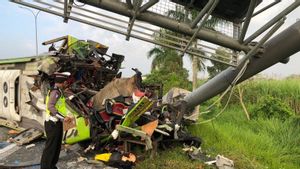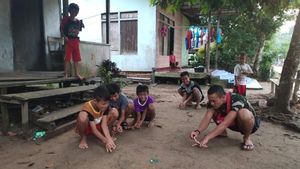JAKARTA - The Toll Road Regulatory Agency (BPJT) of the Ministry of Public Works and Public Housing (PUPR) stated that the progress of the construction of the Semarang-Demak Toll Road Section 2 Sayung-Demak has reached 80.63 percent.
"It is targeted to finish construction by the end of 2022," said BPJT, quoted by Antara, Monday, May 16.
The presence of the Semarang-Demak Toll Road is expected to further complement the connectivity of the toll road network and main arteries on the north side of Java and coupled with the Semarang City Sea Wall facility, it will further support the new economic center in Central Java.
This toll road also functions as a tidal flood barrier and overcomes flooding which has been a problem in the city of Semarang.
The 27 km-long toll road has two sections, namely Semarang/Kaligawe-Sayung with a length of 10.69 km, which is the government's portion with a construction target of 2024.
Meanwhile, Section 2 of the 16.31 km Sayung-Demak segment is the portion of the toll road business entity (BUJT) PT Pembangunan Perumahan Semarang Demak.
The Semarang-Demak Toll Road is equipped with two interchanges (SS), namely Sayung and Demak. Road construction also uses domestic products in the form of PT WIKA Beton precast concrete.
The construction of the Semarang-Demak Toll Road is integrated with a sea embankment with an embankment structure above the sea and is also reinforced with 17 layers of bamboo mats.
VOIR éGALEMENT:
In addition to the bamboo mat system, strengthening of soil conditions is also carried out by installing prefabricated vertical diverting material or PVD and carrying out loading using sea sand material taken using a trailing suction hopping dredger (TSHD).
In an effort to minimize the negative impact on the environment from the construction of the toll road, the Ministry of PUPR in collaboration with the local government has prepared a mangrove land relocation program around the construction of the Semarang-Sayung section. There are three locations of relocated mangroves with a total area of 46 hectares.
Efforts to preserve the mangrove area aim to maintain its function as a habitat for flora and fauna on the north coast of Java and protect the coastline, including reducing the risk of abrasion.
As well as being a breath of fresh air for the surrounding area, the mangroves' robust root system also further helps to form a natural barrier against storm surges and floods. River and land sediments are trapped by roots, which protect coastal areas and slow erosion.
The English, Chinese, Japanese, Arabic, and French versions are automatically generated by the AI. So there may still be inaccuracies in translating, please always see Indonesian as our main language. (system supported by DigitalSiber.id)














